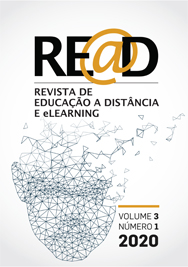Design and Evaluation of a b-learning course for Teachers and Educators Training on Computational Thinking, Programming and Robotics
DOI:
https://doi.org/10.34627/vol3iss1pp131-150Keywords:
Teacher training; Blended learning; Virtual learning environment; Distance education; Online learning.Abstract
This article presents the design of a Virtual Learning Environment (VLE) created as part of a training experience directed to teachers and kindergarten teachers, about computational thinking, programming and robotics in basic and preschool education, as well as its evaluation after the training. This training was conducted within the scope of Project KML II - Laboratory of technologies and learning of programming and robotics for preschool and first cycle of primary education (1st CEB). The training was developed in blended learning format, including classroom and distance sessions. The theoretical frameworks that support this work have their origin in studies on distance education (DE), namely in the developments provided by the designated 3rd generation of DE in which online communication approach has enabled the emergence of new pedagogical scenarios, giving rise to new forms of training, either entirely online or in blended learning format. The training evaluation questionnaire sought to meet the key points that determined the organization of the course and aimed to verify the level of satisfaction and opinion of the participants, as well as gather information that could contribute to the design of a course in MOOC format on the topic. The questionnaire was designed considering various dimensions of training, but in this text we focus in particular on aspects of dimensions related to the evaluation of training in its distance component, namely with regard to VLE.
Downloads
Published
Issue
Section
License
Copyright (c) 2020 Elizabeth Souza, Lúcia Amante, António Quintas-Mendes

This work is licensed under a Creative Commons Attribution-NonCommercial 4.0 International License.
Os autores conservam os direitos de autor pelo seu trabalho e concedem à revista o direito de primeira publicação, com o trabalho simultaneamente licenciado sob uma Licença Creative Commons - Atribuição-NãoComercial 4.0 Internacional.



